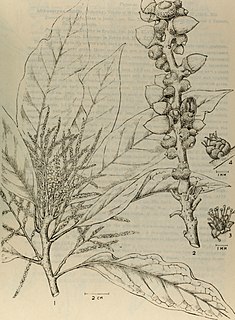Lithocarpus blumeanus is a tree in the beech family Fagaceae. It is named for the German-Dutch botanist Carl Ludwig Blume.
Lithocarpus caudatifolius is a tree in the beech family Fagaceae. The specific epithet caudatifolius is from the Latin meaning "leaf with caudate apex".
Lithocarpus confertus is a tree in the beech family Fagaceae. The specific epithet confertus is from the Latin meaning "crowded", referring to the inflorescences and infructescences.
Lithocarpus daphnoideus is a tree in the beech family Fagaceae. The specific epithet daphnoideus is from the Greek meaning "like Daphne", referring to the genus Daphne and its leaves.
Lithocarpus echinulatus is a tree in the beech family Fagaceae. The specific epithet echinulatus is from the Latin meaning "having short spines", referring to the cupule.

Lithocarpus elegans is a tree in the beech family Fagaceae. The specific epithet elegans is from the Latin meaning "elegant", referring to the acorns and cupules.
Lithocarpus encleisacarpus is a tree in the beech family Fagaceae. The specific epithet is from the Greek meaning "enclosed fruit", referring to the acorns and cupules. The cupule is not fused to the nut though and often becomes irregularly dehiscent. The degree to which the nut is enclosed by the cupule varies across its geographic range. Trees in Lithocarpus are commonly known as the stone oaks and differ from Quercus primarily because they produce insect-pollinated flowers.
Lithocarpus brochidodromus is a tree in the beech family Fagaceae. The specific epithet brochidodromus is from the Latin meaning "loop-veined", referring to the leaves.
Lithocarpus corneri is a tree in the beech family Fagaceae. It is named for the English botanist E. J. H. Corner.
Lithocarpus ewyckii is a tree in the beech family Fagaceae. It is named for D.J. van Ewijck van Oostbroek en De Bilt of the Dutch Colonial Service.
Lithocarpus ferrugineus is a tree in the beech family Fagaceae. The specific epithet ferrugineus is from the Latin meaning "red-brown", referring to the acorn's indumentum.
Lithocarpus gracilis is a tree in the beech family Fagaceae. The specific epithet gracilis is from the Latin meaning "slender", referring to the twigs.
Lithocarpus havilandii is a tree in the beech family Fagaceae. It is named for the British surgeon and naturalist George Darby Haviland.
Lithocarpus keningauensis is a tree in the beech family Fagaceae. It is named for Keningau District in Sabah, to which the species is native.
Lithocarpus kochummenii is a tree in the beech family Fagaceae. It is named for the botanist K. M. Kochummen.
Lithocarpus lucidus is a tree in the beech family Fagaceae. The specific epithet lucidus is from the Latin meaning "shining", referring to the acorn and leaf surface.
Lithocarpus luteus is a tree in the beech family Fagaceae. The specific epithet luteus is from the Latin meaning "golden yellow", referring to the acorn's indumentum.
Lithocarpus mariae is a tree in the beech family Fagaceae. It is named for the Dutch botanical biographer Maria Johanna van Steenis-Kruseman.
Lithocarpus meijeri is a tree in the beech family Fagaceae. It is named for the Dutch botanist Willem Meijer.
Lithocarpus revolutus is a tree in the beech family Fagaceae. The name is derived from the way in which the margins of the leaves are typically rolled in upon themselves (revolute). Trees in Lithocarpus are commonly known as the stone oaks and differ from Quercus primarily because they produce insect-pollinated flowers.
